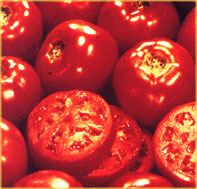Tomatoes
 Tomatoes are a popular greenhouse crop but in most areas can also be grown outdoors.
Tomatoes are a popular greenhouse crop but in most areas can also be grown outdoors.
There are basically two categories of Tomatoes, the Cordon varieties and the Bush varieties.
Cordons are more traditionally greenhouse grown, but a few varieties can be grown outdoors. They are grown as single stems, removing all the side shoots as they form, and need support.
Bush Varieties are more for growing outdoors. The side shoots are left to grow to form a bush shape, hence the name Bush. The fruits are usually a bit smaller than Cordon grown varieties. They do not normally need any support until the fruits have started to swell, when it will be needed to keep the fruits away from the ground. Alternatively, place black polythene sheeting or straw under the plant to keep the fruits off the ground.
All varieties will need to be started off in a propagator or greenhouse unless you intend to buy ready grown plants.
For Tomatoes intending to be used in the greenhouse, sow the seed in pots of compost in January at 50 - 55F. Transplant into 3" pots of compost as soon as 2 leaves have formed. Grow on until ready for planting out into the greenhouse border or into growbags.
Sow the seed of Tomatoes intended for outdoor use in March or April. Transplant into 3" pots, grow on, and plant out under cloches in early May. If you are not going to use cloches, delay planting out until all danger of frost has past.
Tomatoes need an extremely fertile soil that is well drained and has plenty of organic matter, if whether planted in the greenhouse border or outdoors.
When planting into the greenhouse border, space the plants 18" apart. For outdoor plantings space the plants 18" apart with 30" between the rows. Ensure that the plants are kept free of weeds. Keep the watering regular, as letting the plant dry out and then soaking it too much can lead to a disease called Blossom End rot. Remove any side shoots of Cordon varieties as they form.
When the first cluster of fruits starts to form begin feeding with a high Potash fertiliser on a weekly basis. Various commercial Tomato fertilisers can be purchased.
Pick the fruit when they are ripe by holding it in the palm of your hand and gently pinching it away from the plant with your finger and thumbnails. Avoid tearing the stem, as this will be detrimental to any other fruit on the plant.
At the end of the season pick the fruits of outdoor varieties before any frost. Store any green Tomatoes for use into the winter by placing in trays. Remove a few at a time as needed and place in a bag with an apple or a ripe banana. The gas given off will ripen the Tomatoes. Alternatively, any green Tomatoes can be used to make chutney.
The most common problems with Tomatoes tend to be Whitefly and Aphids but there are many other pests and diseases that can affect them. These include Virus, Leaf Roll, Root rot, Tomato Leaf mould, Grey mould, Foot rot, Stem rot, Hormone damage, Eelworm, Verticilium wilt, Magnesium deficiency and Potato blight. (See relevant Pests or Diseases sections)
© copyright 1999, P. A. Owen

